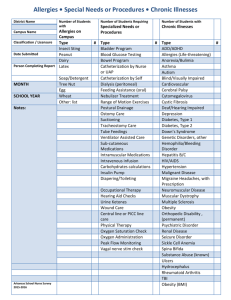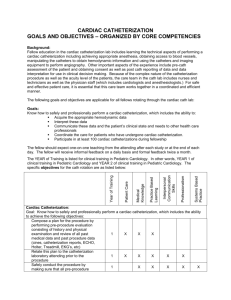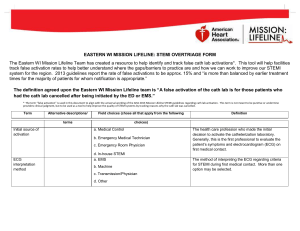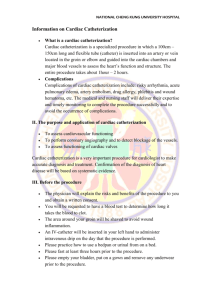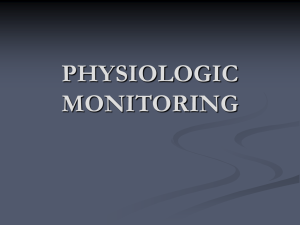Improving Efficiency in Scheduling Catheterizations in a Resource
advertisement
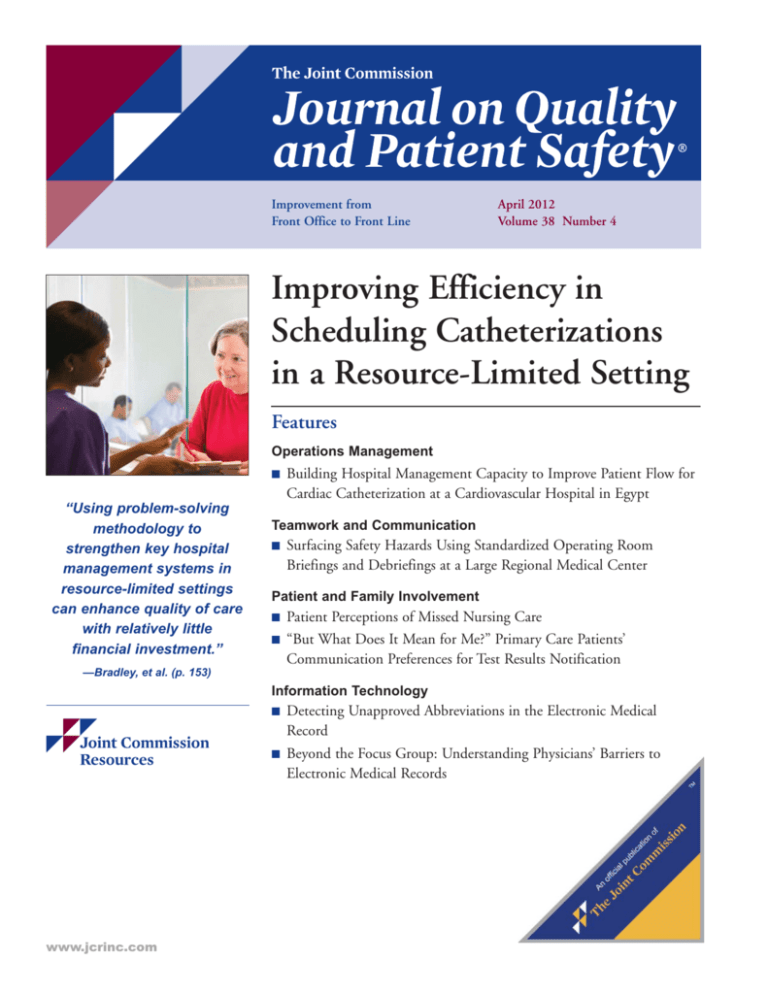
Improvement from Front Office to Front Line April 2012 Volume 38 Number 4 Improving Efficiency in Scheduling Catheterizations in a Resource-Limited Setting Features Operations Management ■ “Using problem-solving methodology to strengthen key hospital management systems in resource-limited settings can enhance quality of care with relatively little financial investment.” Building Hospital Management Capacity to Improve Patient Flow for Cardiac Catheterization at a Cardiovascular Hospital in Egypt Teamwork and Communication ■ Surfacing Safety Hazards Using Standardized Operating Room Briefings and Debriefings at a Large Regional Medical Center Patient and Family Involvement ■ ■ Patient Perceptions of Missed Nursing Care “But What Does It Mean for Me?” Primary Care Patients’ Communication Preferences for Test Results Notification —Bradley, et al. (p. 153) Information Technology www.jcrinc.com ■ Detecting Unapproved Abbreviations in the Electronic Medical Record ■ Beyond the Focus Group: Understanding Physicians’ Barriers to Electronic Medical Records The Joint Commission Journal on Quality and Patient Safety Operations Management Building Hospital Management Capacity to Improve Patient Flow for Cardiac Catheterization at a Cardiovascular Hospital in Egypt Rex Wong, DPT, MPH, MS; Sejal Hathi; Erika L. Linnander, MPH, MBA; Adel El Banna, MD, MBBCH, MSc, PhD; Mohamed El Maraghi, MD, MBA; Randah Zain El Din, MD; Ashraf Ahmed, MD; Abdel Rahman Hafez, BS; Adel A. Allam, MD, FASNC; Harlan M. Krumholz, MD; Elizabeth H. Bradley, PhD Q uality improvement (QI) has been shown to be effective in improving performance and efficiency of hospital care in high-income settings.1–3 Yet the use of data-driven, scientific problem-solving methods to improve hospital quality has been less commonly applied in low- and middle-income countries (LMICs).4–8 Some QI studies in LMICs have shown promise, although most have focused on primary care and communitybased services rather than hospital care.9–11 In Malawi, QI interventions in health worker training and patient records management increased tuberculosis cure rates at the district level.12 Similarly, in Ethiopia, a patient registration system reengineering project in a rural hospital effectively improved data management and physician satisfaction at negligible cost.13 Finally, in Tanzania, training health care workers in integrated management of childhood illness significantly improved quality and efficiency of care in first-level health facilities at no additional cost to districts.14 Despite the lack of literature concerning hospital QI efforts in LMICs, the need for improved efficiency and quality of care is substantial as economies develop, generating greater demand for hospital-based care, and as countries make the transition from infectious to chronic diseases.15–17 For example, 80% of the world’s cardiovascular deaths are in LMICs,9,15,18 where hospital systems are largely underdeveloped. Building management capacity is particularly important in LMICs, where resources are scarce. Research has demonstrated that strategies to improve system efficiency such as streamlining patient flow and redesigning care processes are associated with increased hospital capacity without the need for additional resources, including staff or beds.19 Nevertheless, we could find no studies of QI or management sciences techniques applied to issues of hospital efficiency or quality in the context of cardiovascular care in LMICs. Accordingly, we undertook a two-year effort to apply QI techniques to improve hospital care at the National Heart Institute (NHI) in Cairo, the primary public hospital for cardiovascular disease in the country. Given the increasing prevalence of car- April 2012 Article-at-a-Glance Background: Quality improvement (QI) has been shown to be effective in improving hospital care in high-income countries, but evidence of its use in low- and middle-income countries has been limited to date. The impact of a QI intervention to reduce patient waiting time and overcrowding for cardiac catheterization—the subset of procedures associated with the most severe bottlenecks in patient flow at the National Heart Institute in Cairo—was investigated. Methods: A pre-post intervention study was conducted to examine the impact of a new scheduling system on patient waiting time and overcrowdedness for cardiac catheterization. The sample consisted of 628 consecutive patients in the pre-intervention period (July–August 2009) and 1,607 in the postintervention period (September–November 2010). Results: The intervention was associated with significant reductions in waiting time and patient crowdedness. On average, total patient waiting time from arrival to beginning the catheterization procedure decreased from 208 minutes to 180 minutes (13% decrease, p < .001). Time between arrival at registration and admission to inpatient ward unit decreased from 33 minutes to 24 minutes (27% decrease, p < .001). Patient waiting time immediately prior to the catheterization laboratory procedure decreased from 79 minutes to 58 minutes (27% decrease, p < .001). The percentage of patients arriving between 7:00 A.M. and 9:00 A.M. decreased from 88% to 44% (50% decrease, p < .001), reducing patient crowding. Conclusion: With little financial investment, the patient scheduling system significantly reduced waiting time and crowdedness in a resource-limited setting. The capacitybuilding effort enabled the hospital to sustain the scheduling system and data collection after the Egyptian revolution and departure of the mentoring team in January 2011. Volume 38 Number 4 Copyright 2012 © The Joint Commission 147 The Joint Commission Journal on Quality and Patient Safety diovascular disease in Egypt, a primary concern for hospital quality at the NHI was patient crowding. To address this concern, we engaged the hospital managers and frontline staff in the planning, implementation, and evaluation phases of a redesign of the patient flow management system for cardiac catheterization procedures, the subset of procedures associated with the most severe bottlenecks in patient flow. Using a pre-post intervention design, we tested the hypothesis that changes to patient flow via scheduling interventions would reduce patient waiting time and overcrowdedness, with little incremental cost to the hospital. Methods SETTING The NHI, located in the Imbaba neighborhood of Cairo, has an occupancy rate of 85% to 95% for 390 inpatient beds and treats 800 to 1,000 outpatients per day. The cardiac catheterization laboratory at the NHI has five functional procedure rooms and 40 beds on the postcatheterization patient care units. All five procedure rooms were staffed on Sundays through Thursdays from 8:00 A.M. to 8:00 P.M.; one of those rooms was also staffed for the 8:00 P.M.–8:00 A.M. period and on a 24-hour basis on weekends (Friday–Saturdays; Friday is considered a weekend day and holy day in Egypt) and holidays. Elective cases were not scheduled on Fridays. Weekday patient volume varied on the basis of the clinical teams assigned to a given day. STUDY DESIGN AND SAMPLE We conducted a pre-post intervention study to examine the impact of the quality improvement effort on waiting time and crowdedness at the catheterization laboratory of NHI. The sample consisted of all patients who were scheduled for a specific date for catheterization procedures after being seen by hospital physicians. We excluded patients who were admitted through the emergency room. Patients with a procedure appointment date in July or August 2010 comprised the preintervention sample; the intervention was launched in September 2010, and patients with a procedure appointment date from September through November 2010 comprised the postintervention sample. waited until they could be seen, resulting in long patient waiting times and large numbers of patients loitering at the hospital, particularly in the morning hours. The waiting time was longer if any nonelective cases took priority on a given day. PLANNING THE INTERVENTION A diverse hospital management research team was formed in June 2010 to conduct this project; members included external project mentors [RW, SH, ELL, EHB], the hospital’s quality management team [AEB, MEM, RZED], and catheterization laboratory physicians [including AA], nurses, and administrative staff [including ARH]. In July 2010 the team selected patient crowding and protracted waiting time for the catheterization laboratory as the hospital operating issue to address, and advisory staff facilitated the team’s application of a scientific problem-solving methodology.20 During several work sessions throughout early and mid-July 2010, the full team worked collaboratively to define the problem, understand its root causes, and set objectives. As part of the root cause assessment, the team collected and analyzed essential information, including utilization rate, day-to-day volume variation, duration of various procedures, and length of stay—similar to the measures used by previous studies, such as Siegrist et al.3 and Racine and Davidson.21 From mid-July through early August 2010, the team developed problem-solving strategies and selected the development of a patient scheduling system as the best strategy for intervention. Through the remainder of August 2010, the resulting scheduling plan was discussed with hospital staff, including physicians, nurses, laboratory technicians, and other supporting staff, and was revised multiple times to address their feedback. Multiple training sessions were conducted with the catheterization laboratory staff from mid-August to early September 2010. The new scheduling system was officially launched on September 13, 2010. Although the indicators of interest—waiting time and crowdedness—were monitored throughout the process, we conducted a full evaluation of the intervention in November 2010. IMPLEMENTING THE INTERVENTION PREINTERVENTION Before the intervention, all patients who required elective procedures visited the scheduling office. A scheduler would provide patients an appointment date for the procedures, but no appointment time was given; 60 patients were scheduled for each working day (Sunday–Thursday). In the absence of a functioning patient scheduling system, the majority of patients returned to the hospital early in the morning on the appointment day and 148 April 2012 Patient Scheduling System. A patient scheduling and appointment system was designed and integrated into the work flow for the hospital. Before the intervention, as stated earlier, patients were scheduled for a specific day but were not given an appointment time for their procedure. According to the new scheduling system, patients were given an instruction sheet that outlined preprocedure preparation steps and their appointment time. To incorporate the scheduling flexibility needed to allow for non- Volume 38 Number 4 Copyright 2012 © The Joint Commission The Joint Commission Journal on Quality and Patient Safety elective cases, our scheduling model divided the working day into five blocks. This design was similar to approaches used in other settings to improve catheterization laboratory patient flow.3 A defined number of patients were scheduled according to each time slot, accounting for (1) the number of available beds in the patient care unit, (2) the number of available catheterization laboratory procedure rooms, (3) the average duration of each procedure type, (4) the expected length of stay after each procedure type, and (5) the availability of hospital staff. The proportion of diagnostic to therapeutic cases scheduled in each time slot was crucial in determining the schedule for two reasons. First, after the 40 recovery beds assigned for the catheterization laboratory were occupied, the catheterization laboratory could not schedule any more procedures. Patients receiving diagnostic and intervention catheterizations are required to stay in bed for observation for six hours and overnight, respectively. Therefore, it was advantageous to schedule more diagnostic cases in the morning slots so that, by afternoon, beds could be reopened for other patients. Second, the expected duration of the procedure was different for diagnostic and therapeutic cases, averaging less than 30 minutes and approximately 60 minutes, respectively. For each of the five scheduling windows, a defined combination of diagnostic and therapeutic cases was developed to optimize laboratory utilization. We also allowed for defaulter and nonelective cases when building the scheduling plans. Approximately 15% of all catheterization laboratory cases were nonelective per day, so that scheduling at 85% of maximum capacity would accommodate the unexpected nonelective cases. Nevertheless, because many (up to 12%) of scheduled patients defaulted (that is, were “no shows”), we were able to schedule at 95% of maximum capacity within any given time slot. Scheduling Template. To create the scheduling template, we created a program using a spreadsheet to facilitate data collection and tabulation. The baseline case mix (diagnostic versus therapeutic), duration of procedures, number of available staff at each time slot, and number of available beds and procedure rooms were input into the spreadsheet, which would then provide the maximum number of cases of each type that could be scheduled. The advantage of using a simple spreadsheet was that it could be maintained as the underlying parameters changed. For example, if the number of beds expands to more than 40, or if more procedure rooms are built, catheterization laboratory staff would be able to input the changes and create a different scheduling template. The scheduling templates were revised through discussion with the chiefs of the six cardiology teams to build support for the new system. Six different scheduling tem- April 2012 plates, one for each cardiology team, were created to accommodate their respective resources, case mix, and work hours. Time Stamps. The catheterization laboratory utilization information was obtained from the catheterization laboratory logbooks. Routinely, the laboratory technicians manually record the information, including the total number of patients, the occupancy of each laboratory, procedure type, physician name, and duration of procedures. Time stamps were also collected to obtain information related to patients’ waiting time. Much as has been done in other time-flow studies, we created a time stamp collection form to capture the arrival times of patients at various stations at the hospital.21 On a patient’s arrival at the registration department, a time stamp data recording form was attached to the medical record. Registration staff and nurses at each of the three subsequent stations were responsible for recording on this form the time that patients arrived: the inpatient care ward unit (admission), the preprocedure waiting area (preprocedure), and the procedure room (procedure). At the end of each day, the collection forms would be collected by the catheterization laboratory administrative staff. To enable the catheterization laboratory staff to continually monitor system performance with minimum extra effort, we created two databases—one for utilization and one for the time stamps. After the data clerk entered the information from the logbooks and time stamp collection sheets into these databases at the end of each working day, the preset standard reports in the databases would provide all the needed data regarding utilization rates and waiting times. MEASURES The following four measures of patient waiting times were computed on the basis of the time stamps collected at the various stations: 1. Registration-to-admission time (difference between time stamps recorded when the patients first arrived at the hospital registration department and when the patients were admitted to the inpatient care ward unit) 2. Admission-to-preprocedure time (from the time patients were admitted to the inpatient care ward unit to the time patients were brought to the waiting room outside the catheterization laboratory) 3. Preprocedure-to-procedure time (from the time patients arrived at the waiting room to the time the procedure began) 4. Total waiting time (from registration to the time at which the procedure began). We also recorded the percentage of patients arriving at hospital registration for a catheterization laboratory procedure within each hour of the day. Volume 38 Number 4 Copyright 2012 © The Joint Commission 149 The Joint Commission Journal on Quality and Patient Safety Table 1. Patient Characteristics, Preintervention and Postintervention Preintervention Postintervention %* N %* N P Value Male 377 60 925 58 Reference Female 221 35 670 42 .032 Adult 580 92 1,085 68 Reference Pediatric 18 3 32 2 .865 Diagnostic catheterization 407 65 985 61 Reference Curative catheterization 191 30 511 32 .331 * Total percentages are < 100% because of missing data. Table 2. Patient Wait Times and Arrival Times, Preintervention and Postintervention Preintervention Postintervention Wait Time (Minutes) P Value Registration to admission 33 24 < .001 Admission to preprocedure 100 98 < .001 Preprocedure to start of procedure 79 58 < .001 Total (registration to start of procedure) 208 180* < .001 Percentage arriving during 7:00 A.M.–9:00 A.M. period 88% 44% < .001 Percentage arriving at other times 12% 56% < .001 Arrival Time (%) * The total wait time does not equal the summation of the three components because of missing data regarding time stamps at various stations. DATA ANALYSIS MEASURES For each of the four waiting-time segments, we compared preintervention and postintervention data using Mann-Whitney U test, with the confidence level at α < .005 to determine statistical significance. When we repeated these analyses with a t-test, results were similar. We also assessed changes in the percentage of patients arriving during the 7:00–9:00 A.M. period (the previous rush hours) as compared with other times, evaluating the statistical significance of this difference using chi-square statistics. All data analyses were performed using SPSS version 17.0 (SPSS, Inc., Chicago). The intervention was associated with significant reductions in waiting time and in patient crowdedness. On average, the total patient waiting time from arrival to beginning the catheterization procedure decreased from 208 minutes to 180 minutes (13% decrease, p < .001). The time between arrival at registration and admission to the inpatient care ward unit decreased from 33 minutes to 24 minutes (27% decrease, p < .001). The time that patients waited immediately outside the catheterization laboratory before entering for the procedure decreased from 79 minutes to 58 minutes (27% decrease, p < .001). The percentage of patients arriving during the 7:00–9:00 A.M. period decreased from 88% to 44% (50% decrease, p < .001), reducing patient crowding (Table 2, above). Results SAMPLES Data from a total of 628 consecutive patients comprised the preintervention sample, and data from 1,607 consecutive patients comprised the postintervention sample. The preintervention and postintervention patient samples did not differ significantly by sex, age, and procedure type (Table 1, above). 150 April 2012 Discussion A patient scheduling system significantly reduced waiting time and crowding at the NHI, with the potential for application in other cardiovascular centers in resource-limited settings. It is no- Volume 38 Number 4 Copyright 2012 © The Joint Commission The Joint Commission Journal on Quality and Patient Safety table that this systematic change in business processes did not entail significant investment; the intervention required few resources beyond the time invested by the mentors and the participating hospital staff. The database did not require any hospital expenditure. The only investment needed was a small sum to reprint patient instructions, with the reallocation of one computer and the assignment of administrative staff for data entry. The annual catheterization laboratory maintenance cost remained the same. Two factors were critical to the intervention design: (1) establishing a data infrastructure for evidence-based design and evaluation and (2) a commitment to ongoing mentoring and facilitation throughout the change process. Our experience articulated the vital link between accessible data information and efficient care. The use of a data-driven, scientifically based scheduling template that entailed the availability of beds and procedure rooms, human resources, procedure time, and postprocedure length of stay to produce daily schedules increased the intervention’s feasibility and effectiveness. In addition, the creation of a locally appropriate measurement system—in this case, a database program—to manage data on patient arrival and waiting times, provided valid and reliable feedback on system performance. These tools permitted us to accurately analyze patient flow, evaluate our intervention, and monitor the situation to ensure that improvements were sustained. The research team continued to provide supervisory assistance to the staff after knowledge transfer. A commitment to applied mentoring and facilitation throughout the QI process was critical to engage staff and build skills. To ensure that the data management system would be sustainable beyond the pre-post study, we provided training to nurses and administrative staff in data collection and entry, gradually transferring relevant skills from our research team. By teaching the scientific problem-solving methodology in the preparation phase, we equipped hospital staff with the skill set and the tools to select and address the operating issues significant to them. They became able to define the problem, understand its root causes, implement a strategy, and experience its impact, which encouraged their commitment and empowerment in the change process. We completed the intervention in September 2010. In the wake of the Egyptian revolution that began in January 2011, our formal United States–Egypt collaboration on the project was suspended because of political instability; however, the scheduling system was sustained, and the hospital continued to monitor and evaluate the results. The catheterization laboratory continues to use the scheduling sys- April 2012 tem and to monitor waiting times. The capacity-building effort provided the hospital the skills and tools to not only sustain the project but to also enable continued progress. The hospital’s QI staff maintained the scheduling efficiency project and initiated projects to improve other departments of the hospital by applying the same management science and QI techniques. Although the door-to-balloon time was not affected at completion of this evaluation, additional follow-up projects have been developed (Table 3, page 152). Unfortunately, in many cases their progress has been impeded by the political climate. OVERCOMING CHALLENGES Cooperation from the hospital staff, which took time to develop, was paramount to success. With the support of the hospital’s quality management team, catheterization laboratory director, and senior manager, the improvement process required two months of preparation to engage the full frontline staff in the intervention. The development of a more robust and accurate data collection system was perceived as extra work for many staff. Initially, some nurses did not collect the required time stamps accurately, resulting in poor data quality. We met with the nurses and identified their concerns. For example, after we heard from many nurses that too much time was required to record the time stamps, we simplified the time stamp data collection process by eliminating unnecessary information in the forms, resulting in the nurses’ cooperation. The administrative staff initially perceived computer data entry as extra work but later recognized the associated reduction in work time and effort in report generation. Some staff initially perceived the project as a criticism to their work efficiency and resisted the shift from a clinician-centered to a patient-centered scheduling system. That is, before the intervention, a constant stream of patients would wait to been seen by clinicians; with the new scheduling system, if all procedures in a block were completed ahead of time, clinicians had to wait for the next block to start. We conducted various meetings and discussions with the cardiologists to explain the importance of the scheduling system and to make modifications according to their needs and suggestions. The physicians became more supportive as they observed the less crowded and more efficient work environment, which promoted both staff and patient satisfaction. Similarly, after staff were trained to reliably collect information on patient arrival times and utilization, they acquired a sense of ownership over the new system and became willing stewards and supporters of the intervention. In this way, empowered members of the care team played a key role in relieving the pressure of the catheterization Volume 38 Number 4 Copyright 2012 © The Joint Commission 151 The Joint Commission Journal on Quality and Patient Safety Table 3. Other National Heart Institute Quality Improvement (QI) Projects Projects Project Description and Status 1. Catheterization laboratory physician bonus point computation Objective: To reduce administrative time by developing a spreadsheet program to calculate monthly physician bonus on the basis of productivity, education, and seniority Status: Completed; reduced administrative time by 84%. 2. Catheterization laboratory inventory control Objective: To reduce stock out rate by reengineering the inventory process Status: Inventory software, bar-code system, and supply request process created. 3. Pacemaker registry Objective: To create a data infrastructure to guide QI projects for pacemaker patients Status: Database completed; data entry started 4. Surgical patient scheduling system Objective: To reduce surgical outpatient waiting time through the development of a patient scheduling system Status: In progress 5. Outpatient business process reengineering Objective: To reduce outpatient department crowdedness Status: Assessment completed, proposal submitted, department rearrangement in progress, but the scale of the project was reduced because of the political climate. 6. Fee-waiver approval process Objective: To save time and required staffing by reducing redundancies in the process Status: Started March 2011. The approval process was reengineered to streamline the work flow. Data analysis pending. 7. Hospital medical records system Objective: To improve patient information management through the strengthening of the medical records system Status: Started in March 2011, but now on hold because of the political climate. 8. Acute Coronary Syndrome Registry Objective: To develop data infrastructure needed to measure quality of care for acute coronary syndrome patients Status: Ongoing; more than 2,500 patients entered into the registry 9. Catheterization laboratory private wing Objective: To develop a private wing in the catheterization laboratory to generate extra revenue for the hospital Status: A private wing was established in June 2012 but then reverted back to a regular ward because of the political climate. 10. Catheterization laboratory pre-procedure assessment clinic Objective: To improve the elective case screening and selection Status: On hold because of the political climate. laboratory by strategically controlling the patient flow. Continued support, training, and engagement of all staff were crucial to success. We also faced challenges in patients’ habit of arriving early even if scheduled for a later arrival time. Many patients were skeptical about the change and did not follow the appointment time. Although approximately only 25% of the patients were scheduled in the morning, 44% showed up between 7:00 A.M. and 9:00 AM. Our schedulers consistently emphasized to patients the importance of adherence to the appointments. Despite persistent early arrival, the new schedule system still significantly reduced the wait time between arrival to treatment. 152 April 2012 LIMITATIONS The findings of the study should be interpreted in light of its limitations. First, the study was conducted in a single hospital specialized for cardiovascular care in Egypt; results may differ in other settings. Second, it is possible that errors in data were made; nevertheless, we maintained a close supervision of all data collection personnel through regular monitoring and reminders to limit the inaccuracy of data. However, because it appears unlikely that the measurement error would differ substantially between the preintervention and postintervention periods, data inaccuracy would have had limited influence on the results. Finally, although the scheduling system has been used since the Volume 38 Number 4 Copyright 2012 © The Joint Commission The Joint Commission Journal on Quality and Patient Safety Egyptian revolution, additional follow-up would be required to assess whether the improvements can be sustained over time. Summary Our findings demonstrate that a well-planned patient scheduling system dramatically reduced patient waiting time and catheterization laboratory crowding. By building a locally appropriate data management system and by training staff to apply this data to evidence-based decision making, hospital staff were empowered to drive the patient flow process well into the future. The results and effectiveness thus far of our intervention suggest that using problem-solving methodology to strengthen key hospital management systems in resource-limited settings can enhance quality of care with relatively little financial investment. J The financial support for the project mentors was generously provided by the National Bank of Egypt. Dr. Krumholz is supported by grant U01 HL105270-02 (Center for Cardiovascular Outcomes Research at Yale University) from the National Heart, Lung, and Blood Institute. He is the recipient of a research grant from Medtronic, Inc., through Yale University and is chair of a cardiac scientific advisory board for UnitedHealth. Rex Wong, DPT, MPH, MS, is Director, Hospital Strengthening, Global Health Leadership Institute, Yale University, New Haven, Connecticut. Sejal Hathi is Student and Global Health Fellow, Yale University. Erika L. Linnander, MPH, MBA, is Associate Director, Implementation and Health Services Research, Global Health Leadership Institute, Yale University. Adel El Banna, MD, MBBCH, MSc, PhD, is Dean and Consultant Cardiac Surgeon, National Heart Institute, Cairo; Mohamed El Maraghi, MD, MBA, is Vice Dean; Randah Zain El Din, MD, is Department Head, Quality Management; Ashraf Ahmed, MD, is Director, Catheterization Laboratory; and Abdel Rahman Hafez, BS, is Research Assistant. Adel A. Allam, MD, FASNC, is Medical Consultant, National Bank of Egypt, Cairo; and Professor, Al Azhar University, Cairo. Harlan M. Krumholz, MD, is Professor, Health Policy and Administration, School of Public Health, Yale University; Professor, Section of Cardiovascular Medicine, Department of Medicine, and Director, Robert Wood Johnson Clinical Scholars Program, Department of Medicine, Yale University School of Medicine; and Director, Center for Outcomes Research and Evaluation, Yale-New Haven Hospital. Elizabeth H. Bradley, PhD, is Professor, Health Policy and Administration, School of Public Health, Yale University, and Robert Wood Johnson Clinical Scholars Program; and a member of The Joint Commission Journal on Quality and Patient Safety’s Editorial Advisory Board. Please address correspondence to Elizabeth H. Bradley, elizabeth.bradley@yale.edu. April 2012 References 1. Berwick DM, et al. Curing Health Care: New Strategies for Quality Improvement. San Francisco: Jossey-Bass, 2002. 2. Institute of Medicine. Crossing the Quality Chasm: A New Health System for the 21st Century. Washington, DC: National Academy Press, 2001. 3. Siegrist RB Jr, et al. Improving patient flow in the cath lab. Healthc Financ Manage. 2009;63(4):92–96, 98. 4. Liu C, et al. Finding the best examples of healthcare quality improvement in Sub-Saharan Africa. Qual Saf Health Care. 2010;19(5):416–419. 5. Clark J. Quality improvement forum sets sights on developing countries and on patients. BMJ. 2003 May 24;326(7399):1110. 6. Bradley E, et al. Hospital quality improvement in Ethiopia: A partnershipmentoring model. Int J Qual Health Care. 2008;20(6):392–399. 7. Smits HL, Leatherman S, Berwick DM. Quality improvement in the developing world. Int J Qual Health Care. 2002;14(6):439–440. 8. Huskins WC, et al. Hospital infection prevention and control: A model for improving the quality of hospital care in low- and middle-income countries. Infect Control Hosp Epidemiol. 1998;19(2)125–135. 9. Reerink IH, Sauerborn R. Quality of primary health care in developing countries: Recent experiences and future directions. Int J Qual Health Care. 1996; 8(2):131–139. 10. Mansour M, Mansour JB, El Swesy AH. Scaling up proven public health interventions through a locally owned and sustained leadership development programme in rural Upper Egypt. Hum Resour Health. 2010;8(1):1. 11. Abt Associates. Strengthening Egypt’s Health Sector Reform Program: Pilot Activities in Suez: Executive Summary. Gaumer G, Rafeh N. Oct 2005. Accessed Feb 14, 2012. http://www.abtassociates.com/reports/ES_egypt_health _reform_suez_1005.pdf. 12. Kelly PM. Local problems, local solutions: Improving tuberculosis control at the district level in Malawi. Bull World Health Organ. 2001;79(2):111–117. 13. Wong R, Bradley EH. Developing patient registration and medical records management system in Ethiopia. Int J Qual Health Care. 2009;21(4):253–258. 14. Bryce J, et al. Improving quality and efficiency of facility-based child health care through Integrated Management of Childhood Illness in Tanzania. Health Policy Plan. 2005;20 Suppl 1:i69–76. 15. Reddy KS. Cardiovascular disease in non-Western countries. N Engl J Med. 2004 Jun 10;350(24):2438–2440. 16. Guilbert JJ. The world health report 2002—Reducing risk, promoting healthy life. Educ Health (Abingdon). 2003;16(2):230. 17. World Health Organization. Country Cooperation Strategy for WHO and Egypt, 2005–2009. Cardiovascular Disease: Prevention and Control. Accessed Feb 27, 2012. http://www.who.int/countryfocus/cooperation_strategy/ccs_egy _en.pdf. 18. World Health Organization. The World Health Report: Making a Difference. 1999. Accessed Feb 14, 2012. http://www.who.int/whr/1999/en /index.html. 19. Litvak E, Bisognano M. More patients, less payment: Increasing hospital efficiency in the aftermath of health reform. Health Aff (Millwood). 2011; 30(1):76–80. 20. Rakich JS. Quality, CQI, and reengineering in health services organizations. J Health Soc Pol. 2000;13(3):41–58. 21. Racine A, Davidson AG. Use of a time-flow study to improve patient waiting times at an inner-city, academic pediatric practice. Arch Pediatr Adolesc Med. 2002;156(12):1203–1209. Volume 38 Number 4 Copyright 2012 © The Joint Commission 153


